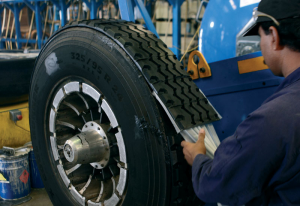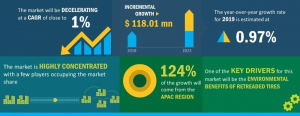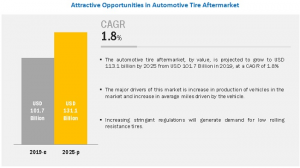Tire Retreading is the process in which the worn casing of a tyre is removed from the car and is replaced with renewed tread. This process is also called tire remolding. The new rubber is vulcanized to the original casing. Retreads are used in all types of vehicles today. Tyre Retreading is an eco-friendly process. Carbon Dioxide emission reduces and a lot of oil gets saved which would otherwise have been utilized in the manufacturing of new tyres. Tyre Retreading can be done at least twice or thrice and this is cost-effective, it saves around 40% of one’s money.

Start a Business in Rubber Manufacturing Industry, Click Here
Opportunities for Tire Retreading Manufacturing Industry
The global retread market is quite positive. It is forecasted to grow at a CAGR of 4.6 % up to the year 2028.The environmental benefits along with the government regulations for the quality manufacture has been propelling the growth of retreading market opening up more and more opportunities for new manufacturers.
Over the past decade, the market for retreaded tyres has grown at a significant rate. Over the time as the development has taken place the manufacture of high standard tyres has increased and along with it the retreaded industry has been growing because retreaded tyres help in cost reduction. The key players in the market are ensuring quality and good operational life. They are coming up with new strategies.
Ever-expanding automotive industry in regions like Europe and China has generated numerous opportunities for manufacturers and distributors of retread tyres. The North American market is forecasted to experience great demand for retread tyres. France, Italy, Germany, Spain, and England are expected to hold a dominant share of the market throughout the forecast period given the popularity of German cars in the international market, Germany remains a key player in the sales of retread tyres.
Read Similar Articles: Rubber Projects
For India, the government has introduced GST and SST which has given a boost to the automotive industry. The rising population of India also serves as a source of opportunity for the expansion of the retread tyres market in India. In China, the policies related to the re-use of materials have been favoring the growth of tyre retreading market. The demand for equipment’s like harvesters which utilize molded tyres have risen. The average age of vehicles has increased because of the quality improvement in the automotive manufacturing sector. Large number of people maintain old vehicles as an alternative, this has propelled the growth of repair and thus the tyre retreading market.
Features of our Report:
• This study assists you in identifying a profitable project for investing or diversifying into by highlighting important factors such as industry size, product demand, and motivations for investing in the product.
• The definition, attributes, and segmentation of the product are all included in this report.
• By identifying the product's target client group, this report assists you in properly marketing and positioning the product.
• This report clarifies the project's viability by revealing data such as the raw materials required, the production method, project costs, and a summary of other project financials.
• Forecasts of key metrics are included in the report, which aid in anticipating industry performance and making informed business decisions.
Watch Video: Tyre Retreading Business. Retread Tire | Start an Automobile Tyre Retreading Industry.
Items in Our Pre-Feasibility Study Report:
A production value analysis, which comprises raw material analysis, product fee trend, Mergers & Acquisitions, growth, major product suppliers, Tire retreading' marketplace awareness charge, and manufacturing process analysis, is also included in the pre-feasibility research. To support our clients' business goals, we deliver continual techno-economic feasibility analyses that meet cost, time, and quality criteria. The characteristics of the tire retreading market, including industry growth drivers, challenging situations, opportunities, risk, restrictions, and dangers, were examined by Entrepreneur India. We've worked hard to find new project prospects, source technology and industrial know-how from Europe, South Asia, and the United States, and keep up with the changing industrial landscape and the expanding demands of Indian and foreign entrepreneurs and business houses. The report also includes a market result characteristics analysis that focuses on technical progress, consumer demand patterns, and external environmental exchange to aid startups and entrepreneurs.
This information should be studied by entrepreneurs, researchers, professionals, commercial business strategists, and anybody else interested in the tire retreading sector. The pre-feasibility study investigates the market's drivers and constraints, as well as their influence on demand during the forecast period. An in-depth understanding of how value is created at each level is provided by a cost chain analysis. The study also considers all of the crucial factors that a business should think about before joining the tire retreading industry. In the report, each product category is given a thorough market analysis.
Watch other Informative Videos: Rubber and Rubber Products, Rubber based Industries, Natural Rubber, Synthetic Rubber, Rubber Chemicals, Extruded Rubber, Adhesives & Sealants

Latest Market Trends of Tire Retreading Industry:
Commercial vehicles hold the largest share in the tire retreading market. Over the years the demand for commercial vehicles has increased at a rate of 4%. This has directly affected the demand for tire retreading. Because of the financial benefit the tire retreading provides, the truck operators have started going for tire retreading. A retread has a cost of around ⅓ or ½ of the total cost of the new tire. The key players in the Tire Industry across the globe, have set up their centers to provide retreaded tires many big players in the Tire industry are setting up centers globally to provide retreaded tires. The Asia Pacific Continues to be the largest market for tire retreading. Tire Manufacturers have been setting even more tire retreading units in this region.
In developing nations like India and China, income of the people has been rising, which has further led to a change in the lifestyle of people. People have been preferring commercial vehicles. The E-Commerce sector has also been boosting the demand for commercial vehicles. In the case of India, the government has decreased the GST rate of tire retreading from 28% to 18%. Owing to the competitive landscape, Kal Tire opened its tyre retreading facility in Mexico and the location has been strategically kept.
Related Feasibility Study Reports: Rubber and Rubber Products, Rubber based Industries, Natural Rubber, Synthetic Rubber, Tyre, Tire, Rubber Chemicals, Industrial Rubber Products, Rubber for Automobile, Extruded Rubber, Medical, Adhesives & Sealants, Belt, Footwear, Gloves, Injection Parts

Looking for Most Demandable Business Ideas for Startups
Tire Retreading Process:
The following steps are used for tyre retreading process:
Collection of Casings
Worn tyres are collected.
Initial Inspection
The collected tyres are inspected thoroughly. Along with the inspectors, on-destructive inspection items like Newera inspection machines are used.
Buffing
The tyre’s old tread is mechanically removed. The buffers accurately remove the right amount of old rubber.
Section Repairs
With advances, many tyres can be repaired on a routine basis and when the original tread is worn off, in most cases tyres can be retreaded.
Cementing and Filling
The injuries in tyres can be cemented and to fill the journey, a vulcanizing rubber can be used.
Building
Under the building process, the pre-cured tread rubber is applied.
Enveloping and Curing
The built tyres are mounted with envelopes. The involved tyres are then vacuumed. The tyre is cured by placing it in the curing chamber. With the help of vulcanizing process, the pre-cured tread gets adhered to the tyre, after which final inspection takes place.
Read our Books Here: Rubber Processing and Compounding Technology Books, Rubber Processing Chemicals Technology
Our Strategy:
• Our research papers cover Indian markets in general, including current analysis, outlook, and forecasts.
• Secondary research is used to produce market projections, which are then cross-validated through interactions with industry participants.
• We rely on trusted data sources and databases. We process information from these sources and include it in the report.
Benefits of Using Our Tyre Retrading Project Report:
The study begins by strengthening the entrepreneur's basic knowledge of the main product by illuminating aspects such as product description, uses and applications, industry segmentation, and a general overview of the Indian industrial sector. The study then assists an entrepreneur in determining the product's target client group. It also assists in making solid investment decisions by identifying and then expanding on variables that will contribute to the expansion of product consumption in India, as well as discussing the product's overseas commerce, including a list of the top importing and exporting countries.
Business Ideas with Low, Medium & High Investment
The report provides a graphical representation of the major statistics addressed in the preceding part, as well as forecasts. It goes on to explain the product's potential for expansion. Other market data is included in the study, such as important companies in the industry category, their contact information, and recent developments. It contains critical information such as raw material needs, a list of machinery, and the plant's manufacturing process. The report also includes core project financials such as plant capacity, project setup costs, working capital requirements, and estimated revenue and profit.
Start a Business in Potential Countries for Doing Business
Tire Retreading Manufacturing Industry FAQs
1. How Big Is the Tire Retreading Market?
Tire Retreading Market size was valued at around $9.02 billion last year. It is expected to grow at a CAGR of 4% and reach $12.36 Billion in the next 7 years.
2. Which type of vehicle requires a high demand for tire retreading?
LCV and HCV require a high demand for tire retreading.
3. Which one is the most profitable market for retread tyre?
East Asia accounts for more than one-third of total demand throughout the forecast period.
Best Industry for Doing Business
Conclusion:
The tire retreading project report focuses on enhancing the entrepreneur's basic knowledge of the main product by presenting specifics such as the product description, its applications, and programs, enterprise segmentation, and an average appraisal of the Indian industrial region. We, at Entrepreneur India, give comprehensive data on the project, which meets all of the needs of a startup or entrepreneur and has a significant boom potential in the marketplaces, thanks to our solid experience in project consultancy and market research.
See More Links:
Startup Consulting Services
Start a Business in Asia
Start a Business in Africa
Start a Business in India
Start a Business in Middle East
Related Videos
Related Books
Related Projects
Related Market Research Reports
DD_Art2022